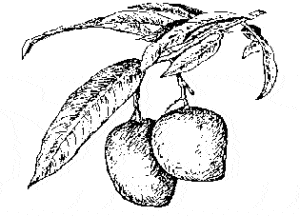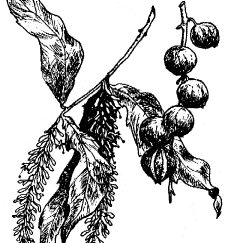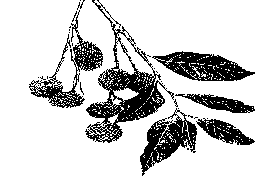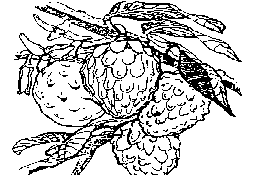AVOCADO
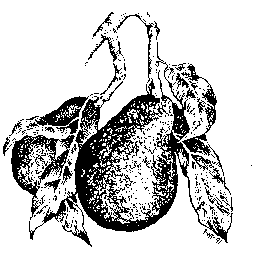
Persea species
Lauraceae
Common Name: Avocado, Alligator Pear (English); Aguacate, Palta (Spanish)
Origin: The avocado probably originated in southern Mexico but was cultivated from the Rio Grande to central Peru before the arrival of Europeans.
Species: Guatemalan (Persea nubigena var. guatamalensis L. Wms.), Mexican (P. americana var. drymifolia Blake), West Indian (P. americana Mill. var. americana). Hybrid forms exist between all three types.
Related species: Coyo (Persea schiedeana Nees), Anay (Beilschmiedia anay Kosterm)
Adaptation: Avocados do well in the mild-winter areas of California, Florida and Hawaii. Some hardier varieties can be grown in the cooler parts of northern and inland California and along the Gulf Coast. The northern limits in California is approximately Cape Mendocino and Red Bluff. Avocados do best some distance from ocean influence but are not adapted to the desert interior. West Indian varieties thrive in humid, tropical climates and freeze at or near 32° F. Guatemalan types are native to cool, high-altitude tropics and are hardy 30 – 26° F. Mexican types are native to dry subtropical plateaus and thrive in a Mediterranean climate. They are hardy 24 – 19° F. Avocados need some protection from high winds which may break the branches. There are dwarf forms of avocados suitable for growing in containers. Avocados have been grown in California (Santa Barbara) since 1871.
DESCRIPTION
Growth Habit: The avocado is a dense, evergreen tree, shedding many leaves in early spring. It is fast growing and can with age reach 80 feet, although usually less, and generally branches to form a broad tree. Some cultivars are columnar, others selected for nearly prostrate form. One cultivar makes a good espalier. Growth is in frequent flushes during warm weather in southern regions with only one long flush per year in cooler areas. Injury to branches causes a secretion of dulcitol, a white, powdery sugar, at scars. Roots are coarse and greedy and will raise pavement with age. Grafted plants normally produce fruit within one to two years compared to 8 – 20 years for seedlings.
Foliage: Avocado leaves are alternate, glossy, elliptic and dark green with paler veins. They normally remain on the tree for 2 to 3 years. The leaves of West Indian varieties are scentless, while Guatemalan types are rarely anise-scented and have medicinal use. The leaves of Mexican types have a pronounced anise scent when crushed. The leaves are high in oils and slow to compost and may collect in mounds beneath trees.
Flowers: Avocado flowers appear in January – March before the first seasonal growth, in terminal panicles of 200 – 300 small yellow-green blooms. Each panicle will produce only one to three fruits. The flowers are perfect, but are either receptive to pollen in the morning and shed pollen the following afternoon (type A), or are receptive to pollen in the afternoon, and shed pollen the following morning (type B). About 5% of flowers are defective in form and sterile. Production is best with cross-pollination between types A and B. The flowers attract bees and hoverflies and pollination usually good except during cool weather. Off-season blooms may appear during the year and often set fruit. Some cultivars bloom and set fruit in alternate years.
Fruits: West Indian type avocados produce enormous, smooth round, glossy green fruits that are low in oil and weigh up to 2 pounds. Guatemalan types produce medium ovoid or pear-shaped, pebbled green fruits that turn blackish-green when ripe. The fruit of Mexican varieties are small (6 – 10 ounces) with paper-thin skins that turn glossy green or black when ripe. The flesh of avocados is deep green near the skin, becoming yellowish nearer the single large, inedible ovoid seed. The flesh is hard when harvested but softens to a buttery texture. Wind-caused abrasion can scar the skin, forming cracks which extend into the flesh. “Cukes” are seedless, pickle-shaped fruits. Off-season fruit should not be harvested with the main crop, but left on the tree to mature. Seeds may sprout within an avocado when it is over-mature, causing internal molds and breakdown. High in monosaturates, the oil content of avocados is second only to olives among fruits, and sometimes greater. Clinical feeding studies in humans have shown that avocado oil can reduce blood cholesterol.
CULTURE
Location: Avocados will grow in shade and between buildings, but are productive only in full sun. The roots are highly competitive and will choke out nearby plants. The shade under the trees is too dense to garden under, and the constant litter can be annoying. In cooler areas plant the tree where it will receive sun during the winter. Give the tree plenty of room–up to 20 feet. The avocado is not suitable for hedgerow, but two or three trees can be planted in a single large hole to save garden space and enhance pollination. At the beach or in windy inland canyons, provide a windbreak of some sort. Once established the avocado is a fairly tough tree. Indoor trees need low night temperatures to induce bloom. Container plants should be moved outdoors with care. Whitewashing the trunk or branches will prevent sunburn.
Soil: Avocado trees like loose, decomposed granite or sandy loam best. They will not survive in locations with poor drainage. The trees grow well on hillsides and should never be planted in stream beds. They are tolerant of acid or alkaline soil. In containers use a planting mix combined with topsoil. Plastic containers should be avoided. It is also useful to plant the tub with annual flowers to reduce excess soil moisture and temperature. Container plants should be leached often to reduce salts.
Irrigation: Avocado trees may not need irrigation during the winter rainy season, but watch for prolonged mid-winter dry spells. Over irrigation can induce root which is the most common cause of avocado failure. To test to see if irrigation is necessary, dig a hole 9 inches deep and test the soil by squeezing. If it is moist (holds together), do not irrigate; if it crumbles in the hand, it may be watered. Watch soil moisture carefully at the end of the irrigating season. Never enter winter with wet soil. Avocados tolerate some salts, though they will show leaf tip burn and stunting of leaves. Deep irrigation will leach salt accumulation.
Fertilization: Commence feeding of young trees after one year of growth, using a balanced fertilizer, four times yearly. Older trees benefit from feeding with nitrogenous fertilizer applied in late winter and early summer. Yellowed leaves (chlorosis) indicate iron deficiency. This can usually be corrected by a chelated foliar spray of trace elements containing iron. Mature trees often also show a zinc deficiency.
Frost Protection: It is important to choose a cultivar that is hardy in your area. Mexican types are the best choice for colder regions. Plant above a slope for air drainage, or near the house for added protection. In youth, protect with rugs, towels and such spread overhead on a frame. For further protection heat with light bulbs and wrap the trunk with sponge foam. These measures also permit tender cultivars to become established in borderline locations; established trees are much hardier than young ones. The upper branches can also be top worked with hardy Mexican types, which will protect a more tender cultivar on lower branches, as well as serving as a pollinator. Harvest fruit before the frost season begins. Cold-damaged fruit turns black. Avocados are often in bloom at the time of frost and the flowers are killed, but the tree tends to rebloom. This is especially true of Mexican types.
Pruning: Columnar cultivars require pinching at early age to form a rounded tree. Others need no training. Current orchard practice avoids staking. The best results are obtained by fencing the tree with plastic mesh for the first two to three years. Container and dwarf trees will need constant staking. The skirts of avocado trees are sometimes trimmed to discourage rodents, otherwise the trees are usually never pruned. Branches exposed to sun by defoliation are extraordinarily susceptible to sunburn and will surely die. Such branches should always be whitewashed. It is better to avoid any pruning. Most cultivars are ill-adapted to espalier. They are too vigorous. Avocado fruit is self-thinning.
Propagation: Desired clonal rootstocks can be be propagated by a method known as the etiolation technique. The largest seed are planted in gallon cans and the seedlings are then grafted to a root rot tolerant clonal scion. When the stem of the graft reaches about 1/4 inch in diameter, the top is cut off leaving a whorl of buds just above the graft. A 4 inch band of black tar paper is formed into an extension of the can and filled with vermiculite and placed in a dark box with high temperature and humidity. When growth is some 3 – 4 inches above the vermiculite, the plant is removed into the light where the upper portion quickly assumes a green color. The tar paper collar is removed, the shoot is severed from the seed and then placed in flats where the cuttings are rooted in the conventional manner. Any seed may also be used for rootstock, but Mexican types make the strongest growth and are the most often used. Plant cleaned seeds as soon as they are ripe. The seedling plants are ready to bud the following year. Budding is done in January, when suitable buds are available. Larger stocks are worked by bark grafts in the spring. Scions are collected Dec – Jan after the buds are well-formed. Paint and cover the graft with a moistened plastic bag and place a vented paper bag over the whole.
Pests and diseases: Rats and squirrels will strip the fruit. Protect with tin trunk wraps. Leaf-rolling caterpillars (Tortrix and Amorbia) may destroy branch terminals. Avocado Brown Mite can be controlled by powdered sulfur. Six-spotted Mite is very harmful; even a small population can cause massive leaf shedding. A miticide may be required if natural predators are absent. Snails can be a problem in California.
Two fungi and one virus cause more damage than any pests. Dothiorella (Botryosphaeria ribis) canker infects the trunk, causing dead patches that spreads to maturing fruit, causing darkened, rancid smelling spots in the flesh. Flesh injury begins after harvest and is impossible to detect on outside. Mexican types are immune to trunk cankers but the fruit is not. The disease is rampant near the coast and has no economical control. Root Rot (Phytophthora cinnamomi) is a soil-borne fungus that infects many plants, including avocados. It is a major disease problem in California. Select disease-free, certified plants and avoid planting where avocados once grew or where soil drainage is poor. The disease is easily transported by equipment, tools and shoes from infected soils. Once a tree is infected (signs include yellowing and dropping leaves), there is little that can be done other than cut back on water. Sun Blotch is a viral disease that causes yellowed streaking of young stems, mottling and crinkling of new leaves and occasional deformation of the fruit. It also causes rectangular cracking and checking of the trunk, as if sunburned. It has no insect vector but is spread by use of infected scions, contaminated tools and roots grafted with adjacent trees. It is important to use virus-free propagating wood.
Harvest: The time of harvest depends upon the variety. Commercial standards requires fruit to reach 8% oil content before harvesting. Mexican types ripen in 6 – 8 months from bloom while Guatemalan types usually take 12 – 18 months. Fruits may continue enlarging on the tree even after maturity. Purple cultivars should be permitted to color fully before harvest. Guatemalan types can be stored firm, at 40 – 50° F. for up to six weeks. Mexican types discolor quickly and require immediate consumption.
Miscellaneous: Leaf and seed extracts have been used for a variety of medical application, including treatment of diarrhea and dysentery and as an antibiotic.
CULTIVARS
- Anaheim
- Origin Otto Keup, Anaheim, 1910. Guatemalan. Tree columnar, productive. Fruit very large, to 24 oz., elongated glossy green, seed small, oil 15%. Tenderest of cvs. for coast only. To 32° F. Season July.
- Bacon
- Origin James Bacon, Buena Park, 1954. Hybrid. Tree broad, productive. Fruit small to medium, to 12 oz., round-ovoid, smooth green. Flesh only fair, almost colorless,seed cavity molds rapidly. Hardy for Bay Area, Central Valley. To 25° F. Season December.
- Creamhart
- Origin Orton Englehart, Escondido,1969. Hybrid. Seedling of Reed. Tree open, upright, branching. Fruit medium, to 14 oz., skin green flesh extraordinarily pale,buttery, nearly fiberless. Not alternate bearing. To 30° F. Season April – July.
- Duke
- Origin Bangor (Oroville), 1912. Tree vigorous, open, resists wind. Fruit small, 12 oz., elongated pyriform, waxy green, skin paper-thin. Flesh excellent, oil 21%. Seeds commonly used for rootstocks, resist root rot. Extraordinarily hardy, recovers quickly from freeze, to 22° F. Season October
- Fuerte
- Origin Atlixco, Mexico, intro. Carl Schmidt, 1911. Hybrid. Tree open, spreading, tall. Fruit large to very large, 16 oz., elongated pyriform, skin dark green with numerous small raised pale spots, waxy bloom, skin thin. Flesh good, oil 18%, seed medium. Formerly standard cv. of California industry. Tends to bear in alternate years, unproductive near coast or in north. To 26° F. Season December.
- Ganter
- Origin Albert Rideout, Whittier, 1905. Mexican. Tree tall, spreading, open. Fruit small, to 8 oz., long pyriform, skin paper-thin, pale waxy green. Flesh good, oil 18%. Oldest avocado cv. in California. Quite hardy, for Central Valley floor and far north. To 23° F. Season October.
- Gwen
- Origin Riverside, Robert Whitsell, 1982, patented. Seedling of Hass. Tree dwarf, to 14 ft., low vigor. Fruit small, to 8 oz., a Hass look alike, elongated green, flesh good. Most productive of dwarf avocados, best dwarf for outdoor use, also for containers, greenhouse. Not hardy, to 30° F. Season February – October.
- Hass
- Origin Rudolph Hass, La Habra Heights, 1926. Seedling of Lyon. Guatemalan. Tree rather open, not tall. Fruit medium, to 12 oz., pyriform, skin thick, pebbled, coppery purple. Flesh good, oil 19%, seed fairly small. Currently the standard of the industry. To 26° F. Season July.
- Jim
- Origin John Reinecke, San Diego, 1939. Hybrid. Tree upright. Fruit small to medium, to 10 oz., olive green, with long neck, oil 12%. To 26° F. Season June.
- Lula
- Origin George Cellon, Miami, 1919. West Indian. Tree dense, broad, prolific. Fruit round, slightly pyriform, to 20 oz., slightly rough glossy green, oil 12%. Only West Indian type recommended for California, rather hardy, to 28° F. Season April.
- Lyon
- Origin R. Lyon, Hollywood, 1908. Central American. Tree columnar, slow growing, difficult to propagate, often scion incompatible. Fruit commonly over 24 oz., dark glossy green, rough, pyriform, oil 21%. High quality. Tender, to 30° F. Season April.
- Mexicola
- Origin Coolidge, Pasadena, 1910. Mexican. Tree tall and spreading, vigorous. Fruit small, 5 oz., round pyriform, skin paper-thin, purplish black, waxy bloom. Flesh highest quality, seed very large. Hardiest cv. known, seedlings useful as rootstocks in far north. Recovers rapidly from freeze. Defoliated at 20° F, trunk killed at 17° F. Season September.
- Mexicola Grande
- Seedling selection of Mexicola. Mexican. Tree tall and spreading similar to Mexicola. Fruit 15% – 25% larger than Mexicola and somewhat rounder in shape with better seed/flesh ratio. Skin paper-thin, purple-black. High quality flesh with high oil content. Hardy to about 18° F.
- Murrieta Green
- Origin Colima, Mexico, intro. by Juan Murrieta, 1910. Hybrid. Tree slow growing, easily trained. Fruit large, to 18 oz., oblate, green, resembling Fuerte. Flesh exceptional, oil 18%. Only cv. readily adaptable to espalier. For coast and intermediate. To 27° F. Season September.
- Nabal
- Origin Antigua, Guatemala, intro. by F.W. Popenoe, 1917. Tree dense, columnar. Fruit handsome, large pyriform, to 17 oz., green, skin resembles Fuerte. Flesh exceptionally high quality, oil 16%. Young trees require pinching to force low branching. Tends to bear alternate years. To 27° F. Season July.
- Pinkerton
- Origin John D. Pinkerton, Saticoy, 1972, patented. Guatemalan. Tree dense, productive. Fruit variable in size, 7 to 12 oz., skin thick, pebbled, green. To 30° F. Season November.
- Queen
- Origin Antigua, Guatemala, intro. by E.E. Knight, 1914. Guatemalan. Tree broad. Fruit exceptionally large, to 24 oz., elongated, purple, flesh excellent, oil 13%. Fairly hardy for large cv., worth trying in Bay Area. To 26° F. Season August.
- Puebla
- Origin Atlixco, Mexico, intro. by Carl Schmidt, 1911. Mexican. Tree broad, high branching. Fruit beautiful, medium to large, to 18 oz., ovoid, skin thin, lacquered maroon purple. Flesh excellent, oil 20%. Least hardy Mexican type, to 29° F. Season December.
- Reed
- Origin James S. Reed, Carlsbad, 1948. Hybrid. Tree columnar. Fruit large, to 15 oz., round, skin thick, pebbled, green. Flesh good. To 30° F. Season August.
- Rincon
- Origin Carlsbad, Sam Thompson, 1944. Hybrid. Tree small. Fruit small to medium, 10 oz., green, resembling Fuerte. Flesh good. For coast, Santa Barbara and Ventura. To 27° F. Season January.
- Ryan
- Origin Albert Rideout, Whittier, 1927. Hybrid. Tree low, spreading. Fruit medium, to 14 oz., elongated, otherwise resembles Hass, skin thick, pebbled, purple. Flesh good, oil 25%. For Inland Empire, Bay Area. To 26° F Season August.
- Spinks
- Origin E. Bradbury, Bradbury, 1911. Hybrid. Tree spreading. Fruit medium, to 15 oz., round with small neck, tangelo shaped. Lacquered, coppery purple, outstanding flavor, oil 16%. To 27° F. Season April.
- Topa Topa
- Origin E.S. Thatcher, Ojai, 1912. Mexican. Tree columnar, vigorous. Fruit handsome, elongated pyriform, small to medium, 8 oz., smooth dark purple with white waxy bloom. Skin paper-thin. Flesh rather poor, oil 15%, seed elongated. Seedlings commonly used for rootstocks. Hardy, for far north. To 23° F.
- Whitsell
- Origin Robert Whitsell, Riverside,1982, patented. Hybrid. Hass seedling. Tree dwarf, to 12 feet, low vigor. Fruit small, 6 oz., elongated Hass look alike. Flesh good. Bears in alternate years. For containers and greenhouse only, not hardy. To 30° F. February to October.
- Wurtz (syn. Littlecado)
- Origin Roy Wurtz, Encinitas, 1935. Hybrid. Tree prostrate, difficult to train, low vigor. Fruit dark green, medium, to 10 oz. For containers and greenhouse. To 26° F. Season July.
- Zutano
- Origin R.L. Ruitt, Fallbrook, 1926. Hybrid. Tree columnar. Fruit small to medium, to 10 oz. elongated smooth green, resembles Fuerte but inferior, has fibers. Hardy for Bay Area, Central Valley. To 25° F. Season November.
FURTHER READING
- See generally: California Avocado Society Yearbook, 1915 to present.
- Davenport, T.L. Avocado Flowering, Hort. Reviews 8: 257-289.
- Koch, F.D. Avocado Grower’s Handbook, Bonsall Publications, 1983.
- Morton, Julia F. Fruits of Warm Climates. Creative Resources Systems, Inc. 1987. pp. 91-102.
- Ortho Books. All About Citrus and Subtropical Fruits. Chevron Chemical Co. 1985. pp. 16-19.
© Copyright 1996, California Rare Fruit Growers, Inc.
Questions or comments? Contact us.


